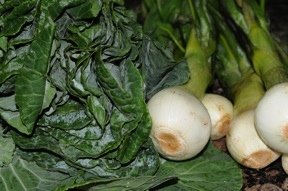Food News You Can Use - Greens
 Collard greens and cabbage are two of the best bargains in the grocery store for both nutrition and cost. Ounce for ounce they are both nutritional powerhouses. They are high in nutrients and phytochemicals, plant chemicals that may be beneficial to your health. But they are also low in sugar, fat and sodium.
Collard greens and cabbage are two of the best bargains in the grocery store for both nutrition and cost. Ounce for ounce they are both nutritional powerhouses. They are high in nutrients and phytochemicals, plant chemicals that may be beneficial to your health. But they are also low in sugar, fat and sodium.
As we picked them up and took them to our favorite farmer?s market counter, one woman remarked, ?those are interesting, what do you do with them?? Good question! And to that we say, ?buy them and then use them all week.? If you have them on hand, that is half the battle.
Cabbage is more easy to find uses for - you can slice it and use it in salads, slaws, tacos and stir fry dishes during the week. For those who like to cook more you can steam it and use it as a wrap for rice stuffings or asian stir fry dishes.
Collard greens have a variety of recipes found on the internet. Our favorite dish doesn?t really need a recipe - we sauteed sweet onions and peppers and added on sliced collard greens and steamed them all lightly in a pan. Some classic recipes call for extended cooking to make them very tender. It is a matter of personal preference.
Other uses for collard greens involve adding them to steamed veggie mixes, shredding to add more color to salads, adding to soups, stir fry dishes, pasta, rice and steamed spinach (we like to use that as a base for fish or chicken).
Collards go well with Southern style dishes like oven fried chicken, Ham Baked Chicken (this issues), baked sweet potatoes and corn bread.
Pantry Check
Go Green With Greens:?Keep them stored in loose fitting?plastic bags - these protect?them from odors and keep?them fresh but they still allow?air to circulate so they don?t?get soggy.
Slice and rinse them and keep?them ready to add to recipes?during the week.
Serve with fresh lemon or lime?or flavored vinegars so they?have a nice flavor without a lot?of added fat.
If they are new to family members,?offer them on the side so?everyone may try them when?ready - it may take a few tries?to get pickier eaters to taste?them.
Try a new green each week?and get in the habit of keeping?them on hand. Green veggies?are an official vegetable group?of the Dietary Guidelines for?Americans.
The easiest green to start using?is cabbage because almost?everyone will accept this vegetable?as a slaw or chopped into?salad. It is very inexpensive?and readily available in all grocery?stores.


